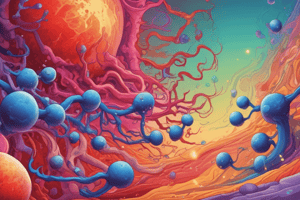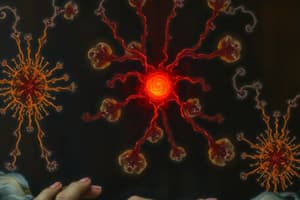Podcast
Questions and Answers
What is the primary function of inflammation?
What is the primary function of inflammation?
- To increase blood flow to the affected area
- To prevent the spread of infection
- To improve the immune system's response to infection
- To destroy and neutralize harmful agents (correct)
Which of the following is NOT a clinical sign of inflammation?
Which of the following is NOT a clinical sign of inflammation?
- Tumor
- Rubor
- Dolor
- Purpura (correct)
What does the term "Functio laesa" refer to in the context of inflammation?
What does the term "Functio laesa" refer to in the context of inflammation?
- Swelling
- Loss of function (correct)
- Increased blood flow
- Pain
Which of the following is an example of an endogenous stimulus that can trigger inflammation?
Which of the following is an example of an endogenous stimulus that can trigger inflammation?
What is the Greek root for the suffix "-itis"?
What is the Greek root for the suffix "-itis"?
What are the two major types of inflammation mechanisms?
What are the two major types of inflammation mechanisms?
Which of the following is NOT a major mechanism of inflammation?
Which of the following is NOT a major mechanism of inflammation?
During the alteration phase of inflammation, what changes occur?
During the alteration phase of inflammation, what changes occur?
Which type of cell is primarily responsible for phagocytosis?
Which type of cell is primarily responsible for phagocytosis?
What are the three main processes that occur at the site of inflammation due to the release of chemical mediators?
What are the three main processes that occur at the site of inflammation due to the release of chemical mediators?
What are the roles of lysosomes in phagocytosis?
What are the roles of lysosomes in phagocytosis?
What is chemotaxis?
What is chemotaxis?
What happens when highly virulent microorganisms kill the leukocyte during phagocytosis?
What happens when highly virulent microorganisms kill the leukocyte during phagocytosis?
Acute inflammation is a short-term response to injury, typically lasting minutes to days.
Acute inflammation is a short-term response to injury, typically lasting minutes to days.
Chronic inflammation is a long-term response to injury, often lasting months or years.
Chronic inflammation is a long-term response to injury, often lasting months or years.
Which of the following is NOT a characteristic of acute inflammation?
Which of the following is NOT a characteristic of acute inflammation?
Which of the following is a characteristic of chronic inflammation?
Which of the following is a characteristic of chronic inflammation?
What is the primary mechanism by which inflammation terminates?
What is the primary mechanism by which inflammation terminates?
What is a major difference between acute and chronic inflammation?
What is a major difference between acute and chronic inflammation?
Which of the following is NOT a primary outcome of inflammation?
Which of the following is NOT a primary outcome of inflammation?
What is the role of angiogenesis in chronic inflammation?
What is the role of angiogenesis in chronic inflammation?
What is a major characteristic of complete resolution in acute inflammation?
What is a major characteristic of complete resolution in acute inflammation?
What is a characteristic of a chronic infection, but not an acute infection?
What is a characteristic of a chronic infection, but not an acute infection?
Which of the following is a possible outcome of an acute inflammation?
Which of the following is a possible outcome of an acute inflammation?
What is the primary factor that leads to chronic inflammation?
What is the primary factor that leads to chronic inflammation?
What is a key difference between the onset of acute and chronic inflammation?
What is a key difference between the onset of acute and chronic inflammation?
What type of immune cell is commonly associated with acute inflammation?
What type of immune cell is commonly associated with acute inflammation?
Why is abundant fibrin exudation associated with healing by connective tissue replacement (fibrosis)?
Why is abundant fibrin exudation associated with healing by connective tissue replacement (fibrosis)?
Which of these are NOT characteristics of chronic inflammation?
Which of these are NOT characteristics of chronic inflammation?
What is true about the duration of chronic inflammation?
What is true about the duration of chronic inflammation?
What is a hallmark feature of chronic inflammation?
What is a hallmark feature of chronic inflammation?
What is the main difference between complete resolution and healing by fibrosis in terms of tissue repair?
What is the main difference between complete resolution and healing by fibrosis in terms of tissue repair?
What is the primary function of giant cells in chronic inflammation?
What is the primary function of giant cells in chronic inflammation?
Which of the following cells are directly associated with allergic reactions?
Which of the following cells are directly associated with allergic reactions?
Which of the following is NOT a chemical mediator involved in inflammation?
Which of the following is NOT a chemical mediator involved in inflammation?
What is a characteristic clinical manifestation associated with autoimmune diseases?
What is a characteristic clinical manifestation associated with autoimmune diseases?
Which of the following is a distinct feature of an abscess?
Which of the following is a distinct feature of an abscess?
Which of the following is an example of a cytokine implicated in inflammatory processes?
Which of the following is an example of a cytokine implicated in inflammatory processes?
Flashcards
Inflammation
Inflammation
A complex protective reaction of the body to injury.
Clinical signs of inflammation
Clinical signs of inflammation
Common indicators include redness, heat, pain, swelling, and loss of function.
Etiology of inflammation
Etiology of inflammation
Caused by factors like infections (bacterial, viral, fungal) or injury.
Acute vs Chronic Inflammation
Acute vs Chronic Inflammation
Signup and view all the flashcards
Mechanisms of inflammation
Mechanisms of inflammation
Signup and view all the flashcards
Acute Inflammation
Acute Inflammation
Signup and view all the flashcards
Chronic Inflammation
Chronic Inflammation
Signup and view all the flashcards
Neutrophils
Neutrophils
Signup and view all the flashcards
Outcomes of Acute Inflammation
Outcomes of Acute Inflammation
Signup and view all the flashcards
Outcomes of Chronic Inflammation
Outcomes of Chronic Inflammation
Signup and view all the flashcards
Physical agents
Physical agents
Signup and view all the flashcards
Chemical agents
Chemical agents
Signup and view all the flashcards
Immunologic reactions
Immunologic reactions
Signup and view all the flashcards
Local mechanisms
Local mechanisms
Signup and view all the flashcards
Systemic mechanisms
Systemic mechanisms
Signup and view all the flashcards
Phagocytosis
Phagocytosis
Signup and view all the flashcards
Leukocytic infiltration
Leukocytic infiltration
Signup and view all the flashcards
Chemical mediators
Chemical mediators
Signup and view all the flashcards
Macrophages
Macrophages
Signup and view all the flashcards
Cytokines
Cytokines
Signup and view all the flashcards
Clinical Examples of Inflammation
Clinical Examples of Inflammation
Signup and view all the flashcards
Autoimmune Conditions
Autoimmune Conditions
Signup and view all the flashcards
Initial Phase of Acute Inflammation
Initial Phase of Acute Inflammation
Signup and view all the flashcards
Termination of Inflammation
Termination of Inflammation
Signup and view all the flashcards
Chronic Inflammation Characteristics
Chronic Inflammation Characteristics
Signup and view all the flashcards
Inflammation Cycle
Inflammation Cycle
Signup and view all the flashcards
Tissue Replacement
Tissue Replacement
Signup and view all the flashcards
Macrophages in Inflammation
Macrophages in Inflammation
Signup and view all the flashcards
Complete resolution
Complete resolution
Signup and view all the flashcards
Healing by fibrosis
Healing by fibrosis
Signup and view all the flashcards
Removal of cellular debris
Removal of cellular debris
Signup and view all the flashcards
Resorption of edema fluid
Resorption of edema fluid
Signup and view all the flashcards
Chronic inflammation causes
Chronic inflammation causes
Signup and view all the flashcards
Giant cells
Giant cells
Signup and view all the flashcards
Thrombus organization
Thrombus organization
Signup and view all the flashcards
Immature granulation tissue
Immature granulation tissue
Signup and view all the flashcards



